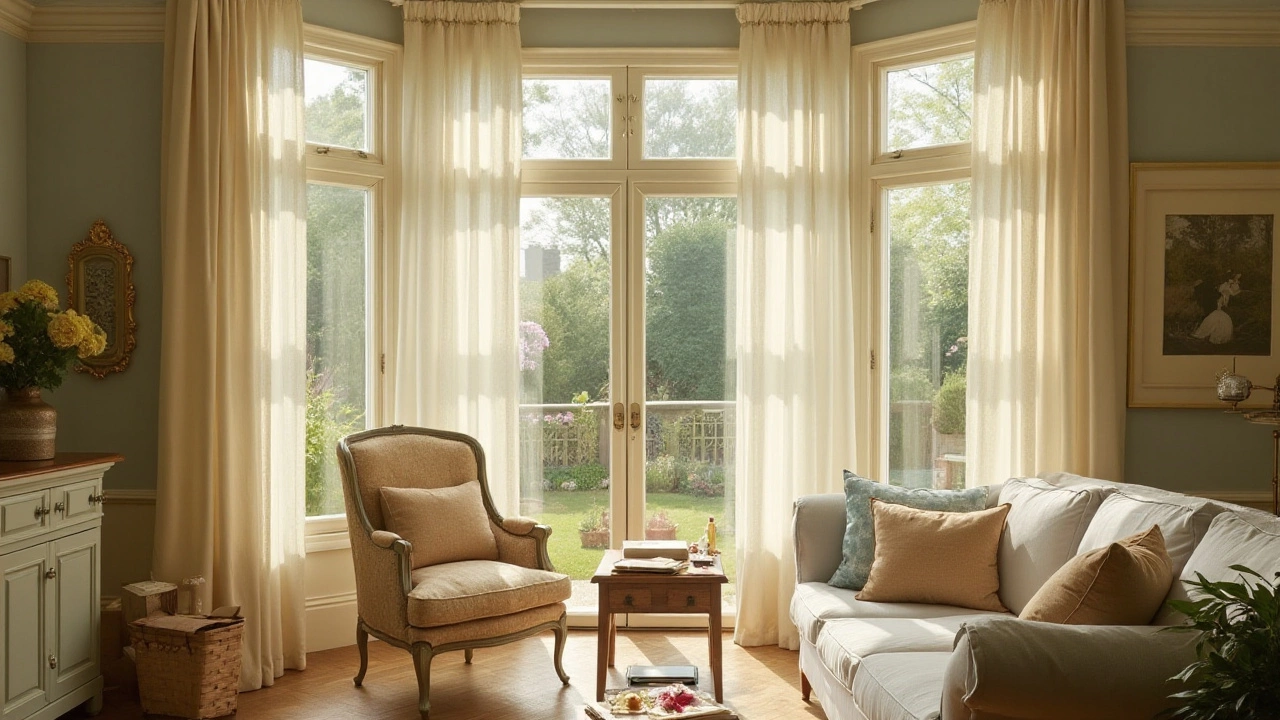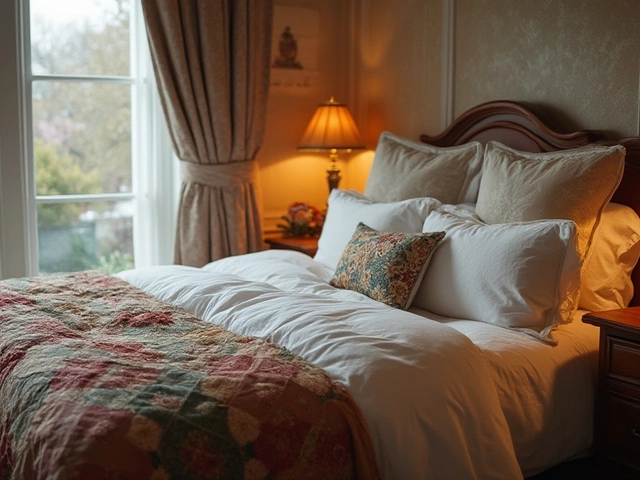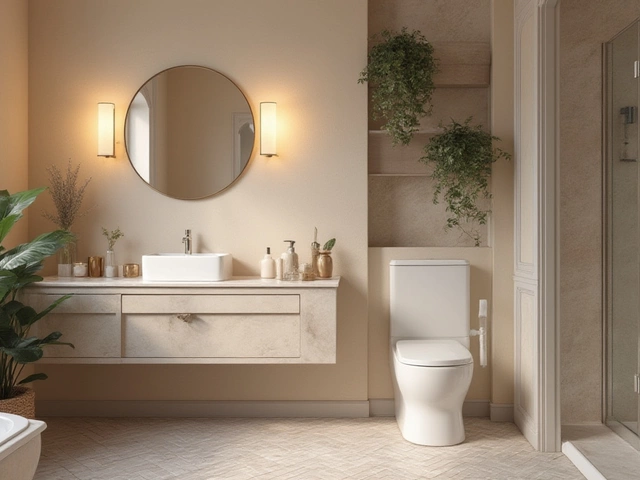Deciding on the perfect curtains isn't just about matching your sofa or picking your favorite shade of blue. It's about crafting an environment that feels as comfortable as it looks. One of the subtle yet powerful ways to manage the temperature of your room is through the color of your curtains.
If you've ever noticed that some rooms feel cooler than others, despite being in the same house, curtain colors might just be the culprit. Light-colored curtains, known for their reflective properties, do wonders in bouncing back sunlight. This simple choice can make a noticeable difference, especially during those fiery summer months.
But it's not only about colors. The type of fabric and weave can also tweak the temperature scales. From airy cotton to heavyweight velvet, the perfect choice varies based on personal needs and your home's unique characteristics. Let’s delve into the world of curtains and uncover how to keep your room chic and chilly.
- The Effect of Curtain Colors on Room Temperature
- Light vs Dark Curtains: What Works Best?
- Material Matters: Choosing the Right Fabric
- Practical Tips for Selecting Cool Curtains
- Innovative Solutions for Modern Homes
The Effect of Curtain Colors on Room Temperature
Choosing the right curtain colors can have a surprising impact on how warm or cool a room feels. This seemingly small decor decision can play a big role, especially during sweltering summer days or chilly winter evenings. The color of the curtains affects how they interact with sunlight—a primary source of natural heat. Light-colored curtains, especially whites, creams, and soft pastels, are known for their reflective properties. They bounce sunlight back out of the window, preventing excess heat from entering the room. In contrast, dark-colored curtains like deep blues, blacks, and dark greys absorb more sunlight, converting it into heat and causing the room to warm up significantly.
There's a scientific explanation behind this phenomenon. The color spectrum plays a crucial role in light absorption and reflection. Lighter colors reflect more sunlight; this is why wearing a white shirt on a sunny day often feels cooler than a black one. The same principle applies to your window decor. According to Carmela Coyle, an interior design expert, "Manipulating curtain colors can reduce the heat gained through windows by up to 25%, potentially shifting room temperature by several degrees."
A study conducted by the Lawrence Berkeley National Laboratory supports this assertion. Their findings revealed that adopting lighter hues for your curtains, especially when paired with high-quality thermal lining, can significantly mitigate heat absorption. A combination of strategic color choice and fabric technology not only preserves a comfortable climate within the home but can lead to energy savings by reducing the need for air conditioning.
Subtle details in home decor choices, such as curtain colors, function as passive climate control methods. These methods offer affordable and sustainable ways to manage interior temperatures. People often overlook how such small adjustments can deliver appreciable comfort benefits. Next time you're updating your interiors, consider how your curtain color choices can stretch beyond improving aesthetics to enhancing comfort and efficiency. Exploring the vast palette of curtain options available allows for an artistic and functional approach to home design that's as kind to your wallet as it is to our planet.
Light vs Dark Curtains: What Works Best?
When it comes to picking curtains, one might think it's purely a style choice, but color can significantly dictate the temperature and comfort of a room. The science is simple yet profound. Light colors, like whites, creams, and pastel hues, are excellent at reflecting sunlight, essentially bouncing the heat back outside. This means during scorching summer days, these colors work as unsung heroes, keeping your house cooler and more energy-efficient. This effect can reduce the dependence on air conditioning, which is not only eco-friendly but also gives your electricity bill a breather.
Conversely, darker shades, such as deep blues, reds, maroons, and blacks, absorb sunlight. While this could be advantageous during chilly winter months when every bit of warmth is needed, it can backfire during the summer, turning your living space into a sauna. An interesting fact about this is that dark-colored curtains can increase the room temperature by as much as 10 degrees Fahrenheit, changing the dynamics of interior comfort drastically.
If you reside in a climate with distinct seasons, you might face a dilemma year-round. Some people choose to switch curtains as the seasons change. For instance, using light-colored curtains in the summer and swapping to darker ones come winter. This not only provides thermal benefits but a fresh aesthetic look twice a year. For those who find this impractical, a dual-layer solution might be ideal. Combining a sheer light inner curtain with a detachable dark outer layer could provide flexibility and function in one go.
In a conversation with a respected interior designer, Jane Matthews, she noted,
"Choosing the right curtain starts with understanding your true needs. A chic space means nothing if it can't provide comfort. Light curtains with thermal linings have become a hit, blending style with function."This insight dovetails perfectly with the principles of creating sustainable and economically savvy homes. In a world growing more conscientious about energy consumption, every little bit helps, doesn't it?
One more thing to think about is the texture and material of the curtain too. For example, a thick light-colored curtain can sometimes perform better than a thin dark one, due to increased insulation. Thick cotton, bamboo blends, and linen are some examples of materials that serve dual purposes—providing a barrier against light and warmth. Considering this, when choosing colors for your curtains, it's vital to also weigh in the kind of fabric they are made from. This choice surely changes the room dynamics and complements the overall curtains palette.
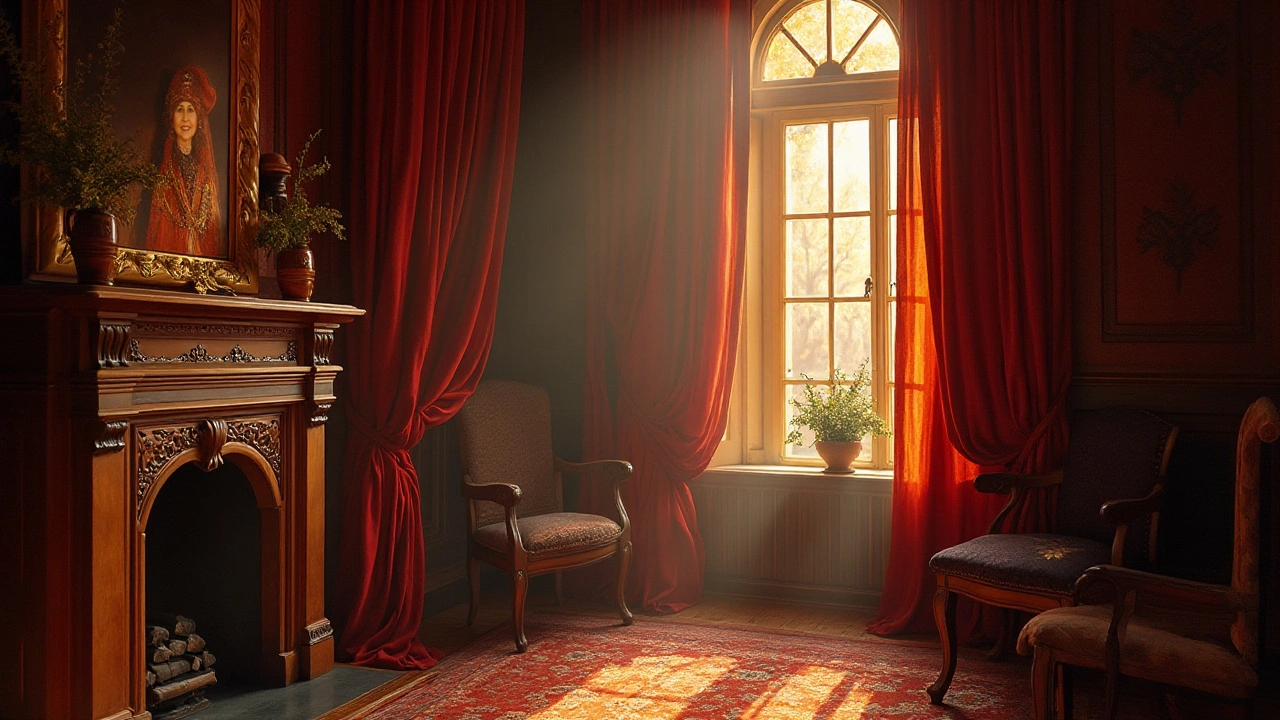
Material Matters: Choosing the Right Fabric
When it comes to curtains, fabric is not merely a cosmetic choice. It plays a critical role in how effectively your room can manage temperature. Think of fabric as the skin of your interior design—critical in regulating warmth and coolness. To start, natural fabrics like cotton and linen are champions in breathability. They encourage air flow, creating a gentle barrier against the harsh rays of the sun while allowing a gentle breeze into the room. This makes them an excellent choice for homes in warmer climates.
On the other hand, heavier options like velvet and brocade provide excellent insulation. This means they can help trap cold air inside during those sweltering summer months, preventing the home from heating up. It turns out that the thickness and weight of your fabric are just as important as the color in ensuring a room stays cool. According to a study from the University of Salford, material thickness can alter room temperatures by as much as five degrees Celsius. This simple consideration can make a real difference on a scorching afternoon.
Room cooling isn't the only aspect to consider. Longevity and maintenance are also key factors. You'll want to consider how much sunlight exposure your curtains will endure and select materials that can withstand fading. Synthetic blends often provide greater longevity than pure natural counterparts and may offer added resistance to sun-induced wear and tear. Fabrics mixed with acrylic or polyester tend to be more durable, retaining shape and color for extended periods. This isn't only good for aesthetics but also for maintaining optimal energy efficiency over time.
The Role of Technology in Modern Curtains
Modern curtain innovations have also brought us fabrics infused with technology. Thermal curtains utilize special coatings and construction methods to boost their insulating properties. Some advanced fabrics come with metallic threads that reflect light, which significantly reduces heat absorption. It's these modern solutions that marry the best of technology and traditional fabric benefits, creating a multi-layered defense against heat.
The National Renewable Energy Laboratory states, "Metallic threading in curtains can reduce heat absorption by up to 30%, making them an ideal choice for energy-efficiency."
- Opt for light-colored, heavy materials if you're in a sunny, hot climate.
- Consider synthetic blends for durability against sun damage.
- Explore innovative fabrics featuring heat-reflective technology for enhanced cooling effects.
Your choices are not just limited to color and fabric type. By opting for the right kind of material, you optimize your interior environment for coolness and comfort, all while maintaining a chic look. The right selection can make your home decor both beautiful and practical, proving that sometimes, curtains can do much more than shield us from the sun's rays—they can transform our living space.
Practical Tips for Selecting Cool Curtains
When shopping for curtains, many often focus on style, length, or pattern, forgetting that these seemingly simple household items play a crucial role in temperature regulation. If keeping your room cool is your aim, there are specific factors you should consider. To start, the color of your curtains is vital. Light colors, especially whites, creams, and soft pastels, are instrumental in reflecting sunlight rather than absorbing it, thus preventing excessive heat from pouring into your home. These colors work marvelously during long summer days when the sun is nearly relentless in its heat. Incorporating sheer curtains can also enhance this effect by allowing natural light to filter through while maintaining privacy and comfort.
The choice of fabric is equally important as it turns out, some materials are better suited for cooling purposes than others. Heavyweight fabrics might seem attractive due to their block-out capabilities, but their heat-trapping properties can contribute to making a room warmer. For optimal cooling, opt for lighter materials such as cotton or linen that allow air to circulate while still offering some level of shade. Interestingly, a study from the Department of Energy highlights that using medium-colored draperies with white-plastic backings can reduce solar heat gain by up to 33%, which is a significant improvement.
While choosing the right curtain colors and materials, don’t forget the practicality of combining shades and blinds. Layering these elements provides added protection against solar radiation, which often results in lowering your overall cooling costs. Simple strategies like these help keep your home cooler. Additionally, reflective materials and linings can be quite effective. If possible, investing in insulated thermal curtains could prove beneficial. These are designed to block out sunlight fully and can help in reducing the heat that enters your room.
The installation method also plays a role in efficiency. Ensure that your curtains hang close to the window. This reduces the space through which heat can escape or enter. Pay attention to the fit—you might consider curtains that extend beyond the window frame to completely cover it. A snug fit without gaps ensures better temperature control. Consider using wrap-around rods to get the closest fit possible.
"Proper curtain placement can impact a room's temperature much more than most homeowners realize," notes interior designer, Sarah Richardson, in a Home & Garden article.
Lastly, seasonal changes might require an update. As seasons transition, swapping your curtains for ones more suited to the climate can help maintain a comfortable room temperature throughout the year. While summer calls for lighter, cool-focused options, winter might welcome heavier drapes to keep warmth in. For those looking for sustainable options, choosing curtains made from organic and recycled materials can complement your eco-friendly goals while still fulfilling your cooling needs. This allows you to enjoy comfort and style while also being conscious of your environmental impact.
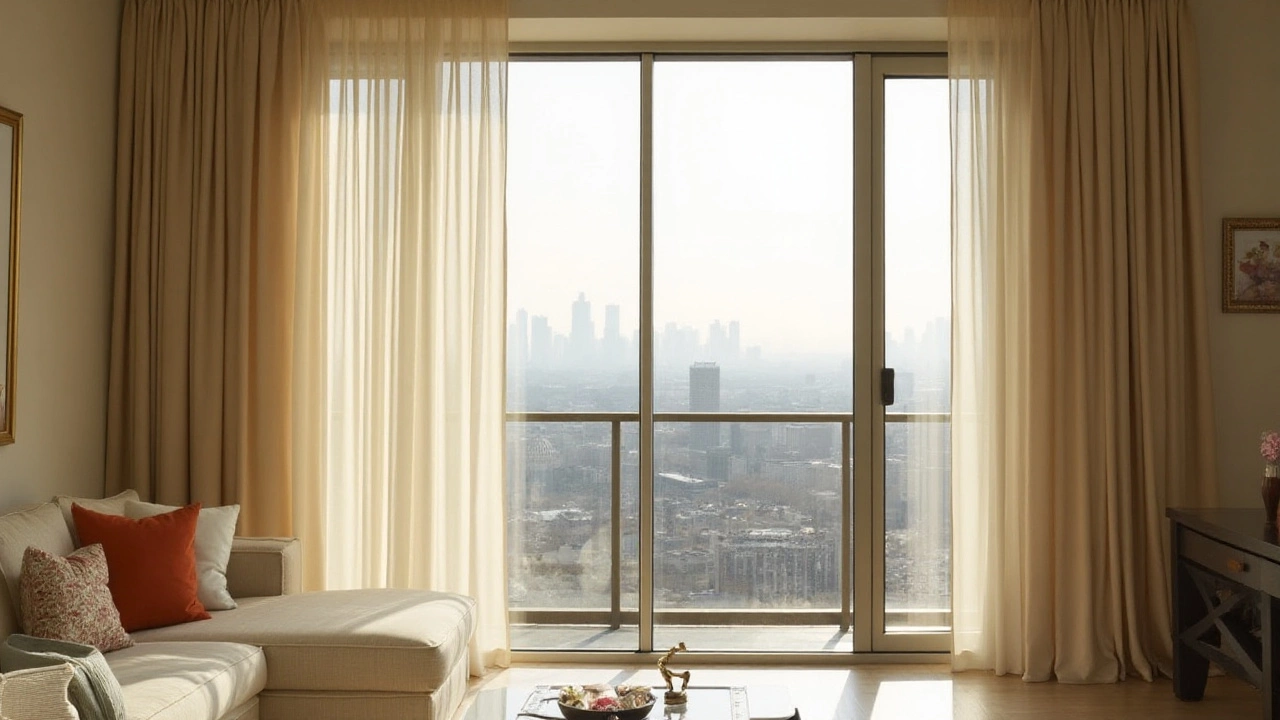
Innovative Solutions for Modern Homes
As we step into the age of smart homes and energy efficiency, ensuring our living spaces stay cool without cranking up the air conditioning becomes a priority. The role of curtains has evolved greatly over the years, now acting as key players in our quest to maintain optimal home environments. Today, curtains aren’t just about hanging fabric; they merge style with cutting-edge technology to provide room cooling solutions.
One of the most exciting advancements in this realm is the development of thermal insulating curtains. These window dressings are designed with special layers that either trap heat inside during winter or block it during the summer. A perfect blend of heavy-duty functional fabric with a fashionable exterior means you don't have to choose between style and utility. As an additional boon, they contribute to reduced energy costs since there's less need for artificial temperature control.
Smart fabrics with reflective coatings are another groundbreaking innovation. These fabrics redirect sunlight away from your interiors while maintaining natural light in the space, a key feature for those unwilling to sacrifice the cheerful ambiance of a sunny room. A study by the Lawrence Berkeley National Laboratory found that reflective window coverings can reduce heat gains in sunny climates by up to 50%, a significant statistic to consider.
Consider incorporating hi-tech features such as automated curtains that can be controlled by your smart home system. Set on timers or connected to weather apps, these curtains adjust in real time according to sunlight levels, ensuring your spaces remain constant in comfort. Imagine curtains that open to let the morning sunlight gently wake you and then close during hot noon temperatures to maintain a cool indoor climate. Such innovations show why automation is fast becoming a desirable aspect of home decor.
“Curtains today do so much more than just create privacy. They’re a key component in sustainable living,” remarks interior designer Fiona Reynolds, a pioneer in eco-friendly home solutions.
In addition to these technological measures, we see hybrid solutions combining both traditional and modern methods. For example, lining lightweight curtains with detachable insulated backings allows flexibility across changing seasons, while still adhering to aesthetic preferences. The ability to adapt and personalize makes this a favored choice for many homeowners.
In summary, employing these advanced solutions can not only enhance the visual appeal of one’s home but also significantly improve living conditions by using fewer resources. People now have the opportunity to integrate these curtain innovations into their homes and enjoy both efficiency and elegance in one seamless package. As the world leans towards more sustainable living options, modern curtain solutions present an opportunity to join the movement while keeping cool in style.

